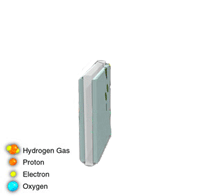Hydrogen Fuel Cell Cars
Hydrogen Fuel cell cars/vehicles turn hydrogen fuel and oxygen into electricity. The electricity then powers an electric motor, just like electricity from batteries powers the motor of an electric vehicle. Fuel cells combine oxygen from the air with hydrogen from the vehicle's fuel tank to produce electricity. When oxygen and hydrogen are combined they give off energy and water (H2O). In fuel cells this is done without any burning (combustion).
A graphic showing how a typical fuel cell works is shown below.

Fuel cell cars/vehicles also known as Zero-Emission Vehicle (ZEV). Because the exhaust from hydrogen-fueled fuel cells is mostly water. There are a number of ways that hydrogen can be provided to the fuel cell. One way is simply to put hydrogen gas into the fuel cell, along with air. Hydrogen gas can come from gaseous or liquid hydrogen stored on the vehicle.
To carry gaseous hydrogen on a vehicle, it must be compressed. When compressed (usually to a pressure of about 3000 pounds per square inch), it must be stored in special high-pressure containers. This is similar to the way compressed natural gas is stored on natural gas-fueled vehicles.
The other way to provide hydrogen gas to the fuel cell is to store it on the vehicle in liquid form. To make hydrogen liquid, it is chilled and compressed. Liquid hydrogen is very, very cold--more than 423.2 degrees Fairenheit below zero! This super-cold liquid hydrogen is the kind used in space rockets. The containers are able to hold pressure, but they are also insulated to keep the liquid hydrogen from warming up. Warming the liquid, or lowering the pressure, releases gas (like boiling water), and the gas can go to the fuel cell.
Another way to get hydrogen to the fuel cell is to use a "reformer". A reformer is a device that removes the hydrogen from hydrocarbon fuels, like methanol or gasoline. When a fuel other than hydrogen is used, the fuel cell is no longer zero-emission, but it still may be very low emitting.
There is also a type of fuel cell that can be fueled with methanol directly. This is called a direct-methanol fuel cell. This type of fuel cell does not need a reformer to separate the hydrogen from the methanol. The fuel cell removes the hydrogen from the liquid methanol inside the fuel cell.
Many people in the vehicle manufacturing business think that fuel cell vehicles may be the technology of the future. However, a lot of work will have to be done to make fuel cell vehicles perform well enough to replace the internal combustion engine in the vehicles we use today. They also will need to be made much less expensive.
At present, fuel cell vehicles have only been developed to what might be called the pre-prototype stage. That means there are very few fuel cell vehicles in existence, and all of them are actually used for testing. Most car manufacturers have or are working on demonstration models, some of which can reach a speed of 90 mph and can travel up to about 280 miles before they need refueling. DaimlerChrysler has developed the NECAR 4 and Ford calls its demonstration model the P2000 Sedan. Some manufacturers claim they will have fuel cell cars available for the public in the next ten years.
- Login to post comments

1 comment for 'Hydrogen Fuel Cell Cars'
1. great to read it, i never
great to read it, i never heard about it before ...
steve
Rent a car in Dubai